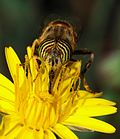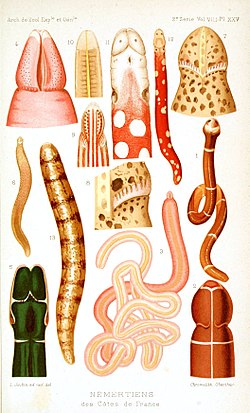A proboscis (/proʊˈbɒsɪs, -kɪs/) is an elongated appendage from the head of an animal, either a vertebrate or an invertebrate. In invertebrates, the term...
10 KB (1,047 words) - 22:03, 5 July 2025
The proboscis monkey or long-nosed monkey (Nasalis larvatus) is an arboreal Old World monkey with an unusually large nose (or proboscis), a reddish-brown...
25 KB (2,736 words) - 20:45, 3 March 2025
In teratology, a proboscis is a blind-ended, tube-like structure, commonly located in the middle of the face. It is commonly seen in severe forms of holoprosencephaly...
4 KB (427 words) - 00:14, 17 August 2023
Anolis proboscis, commonly known as the horned anole, Ecuadorian horned anole or Pinocchio lizard, is a small anole lizard in the family Dactyloidae....
20 KB (2,385 words) - 05:57, 30 June 2025
usually possessing a non-retractable proboscis which can be rolled into a scoop-shape to feed. In some species the proboscis is ribbon-like, longer than the...
26 KB (3,096 words) - 19:09, 24 July 2025
hummingbirds, as they feed on the nectar of tube-shaped flowers using their long proboscis while hovering in the air; this resemblance is an example of convergent...
18 KB (1,925 words) - 10:18, 19 July 2025
proboscis bat (Rhynchonycteris naso) is a species of bat found in South America and Central America. Other common names include long-nosed proboscis bat...
6 KB (558 words) - 10:28, 6 May 2025
Nemertea (redirect from Proboscis worm)
Nemertea is a phylum of animals also known as ribbon worms or proboscis worms, consisting of about 1300 known species. Most ribbon worms are very slim...
63 KB (6,243 words) - 14:38, 23 May 2025
they have a relatively narrow neck, sturdy build, and formidable curved proboscis (sometimes called a rostrum). Large specimens should be handled with caution...
17 KB (1,747 words) - 00:04, 16 July 2025
Acanthocephala (section Proboscis)
or spiny-headed worms, characterized by the presence of an eversible proboscis, armed with spines, which it uses to pierce and hold the gut wall of its...
28 KB (3,263 words) - 10:21, 6 June 2025
Insect mouthparts (section Proboscis)
and defensive appendages. In bees, that feed primarily by the use of a proboscis, the primary use of the mandibles is to manipulate and shape wax, and...
17 KB (1,874 words) - 00:17, 11 July 2025
assassin flies. They are powerfully built, bristly flies with a short, stout proboscis enclosing the sharp, sucking hypopharynx. The name "robber flies" reflects...
29 KB (3,223 words) - 03:44, 12 July 2025
end of the trunk and a flattened proboscis extends forward in front of the mouth. The ventral side of the proboscis has a ciliated channel along which...
5 KB (572 words) - 16:10, 26 October 2023
cigar-shaped body, with a triangular tail fin, two long stalked eyes, and a proboscis tipped with a mouth-like appendage. Based on the fossils, it seems this...
31 KB (3,201 words) - 22:07, 11 July 2025
Arthropod mouthparts (section Proboscis)
on either side of the base of the proboscis or sometimes vestigial or absent. Sea spiders possess a tubular proboscis forward from the body trunk, at the...
10 KB (1,196 words) - 14:30, 1 July 2025
Proboscis extension reflex (PER) is the extension by an insect with an extendable proboscis (e.g. a bee or fly) of her proboscis (sticking out of her tongue)...
7 KB (868 words) - 12:03, 19 January 2024
Proboscis is a genus of butterflies from the subfamily Satyrinae in the family Nymphalidae. The species in the genus Proboscis occur in South America....
967 bytes (47 words) - 16:28, 19 December 2023
Gorgonorhynchus repens is a species of the proboscis worm in the subclass Heteronemertea and of the family Gorgonorhynchidae. It is to be found on the...
4 KB (384 words) - 13:19, 12 February 2025
infests marsupials in Australia and New Guinea. Its body consists of a proboscis armed with hooks which it uses to pierce and hold the gut wall of its...
20 KB (1,925 words) - 18:52, 15 April 2025
proboscis, a short fleshy collar that lies behind it, and a long, worm-like trunk. The creature's mouth is located at the collar behind the proboscis...
22 KB (2,517 words) - 20:51, 30 June 2025
In many animals, the structure is called a muzzle, rostrum, beak or proboscis. The wet furless surface around the nostrils of the nose of many mammals...
3 KB (393 words) - 02:30, 26 May 2025
surmised that the flower was pollinated by a then undiscovered moth with a proboscis whose length was unprecedented at the time. Darwin's prediction went unverified...
47 KB (5,422 words) - 07:28, 24 May 2025
Apenheul Primate Park (section Proboscis monkey)
black bearded sakis, and woolly monkeys. In summer 2011, three adult male proboscis monkeys (9-year-old twin brothers Julau and Bagik, and 10-year-old half-brother...
6 KB (602 words) - 11:01, 16 June 2025
baboons by attaching themselves to the intestines using their hook-covered proboscis. Their life cycle includes an egg stage found in host feces, a cystacanth...
29 KB (2,805 words) - 02:54, 12 July 2025
Africanized bee (section Proboscis extension responses)
different concentrations of sucrose is determined by a reflex known as the proboscis extension response (PER). Different species of honey bees that employ...
56 KB (6,432 words) - 22:47, 17 July 2025
genus Moniliformis are usually pseudosegmented and have a cylindrical proboscis with longitudinal rows of hooks that have posteriorly directed roots....
51 KB (5,822 words) - 03:10, 2 June 2025
shorter specimens often being wider than longer ones. The characteristic proboscis of priapulids is present at the anterior, attached to the trunk of the...
11 KB (1,200 words) - 14:02, 30 April 2025
found to probe its sharp proboscis into the closed eyes of sleeping birds at night to drink their tears. H. hieroglyphica's proboscis is unique among those...
33 KB (3,752 words) - 13:46, 18 July 2025
backwards, and a clawed proboscis that most likely passed food to its mouth. Opabinia lived on the seafloor, using the proboscis to seek out small, soft...
45 KB (4,873 words) - 17:05, 22 May 2025
of the gastrointestinal tract of their hosts using their hook-covered proboscis. Their life cycle includes an egg stage found in host feces, a cystacanth...
39 KB (3,396 words) - 03:33, 9 June 2025



























